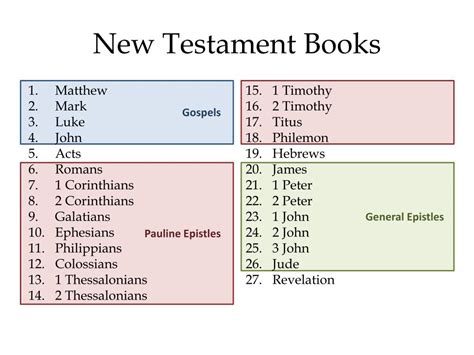When Was The New Testament Written

The New Testament, a fundamental component of the Christian Bible, has a complex and intriguing history regarding its composition and writing. The process of its creation spans several decades, with the exact dates of writing being a subject of ongoing scholarly debate and research. To understand the timeline of the New Testament's writing, it's essential to delve into the historical context, the authors, and the manuscripts that have been passed down through the centuries.
Historical Context and Early Christian Communities

The New Testament writings are closely tied to the life and teachings of Jesus Christ and the early Christian communities that emerged after his death and resurrection. The earliest Christian communities, primarily located in Jerusalem and spreading throughout the Mediterranean world, relied on oral traditions to pass on the stories, teachings, and events related to Jesus. As these communities grew and the need for written records became more pressing, especially with the destruction of Jerusalem in 70 CE, the writings that would eventually form the New Testament began to take shape.
The Earliest Written Records
Among the earliest written records are the letters of Paul, also known as the Epistles. Paul, a prominent figure in early Christianity, wrote to various communities he had founded or interacted with, addressing their questions, resolving disputes, and providing spiritual guidance. The First Epistle to the Thessalonians, likely written around 50 CE, is often considered the oldest written document in the New Testament. Other epistles by Paul, such as Galatians, Corinthians, and Romans, were written over the next couple of decades, providing a window into the theological debates and the organizational structure of the early Christian churches.
| Epistle | Estimated Date of Composition |
|---|---|
| 1 Thessalonians | Around 50 CE |
| Galatians | 55-56 CE |
| 1 Corinthians | 56 CE |
| 2 Corinthians | 56-57 CE |
| Romans | 57-58 CE |

Gospels and the Synoptic Problem

The Gospels, which narrate the life, death, and resurrection of Jesus, were written somewhat later than Paul’s epistles. The exact order and dates of their composition are subjects of ongoing debate among scholars. The Synoptic Gospels (Matthew, Mark, and Luke) share significant similarities, suggesting a literary relationship between them. The majority of scholars believe that Mark was the first Gospel written, possibly around 68-70 CE, with Matthew and Luke using Mark as a source and adding their own material. John’s Gospel, often considered the last of the four to be written, presents a distinct theological perspective and is dated by many scholars to around 90-110 CE.
Other New Testament Writings
Beyond the Gospels and Paul’s epistles, the New Testament includes other writings such as the Acts of the Apostles, the General Epistles (James, 1 and 2 Peter, 1, 2, and 3 John, and Jude), and the Book of Revelation. These texts were written over the late 1st and early 2nd centuries CE, reflecting the growing diversity and challenges faced by the Christian communities as they spread throughout the Roman Empire.
Key Points
- The New Testament writings began with Paul's epistles, the earliest of which, 1 Thessalonians, dates back to around 50 CE.
- The Gospels, starting with Mark, were composed later, with the majority of scholars dating Mark to around 68-70 CE.
- The process of writing the New Testament texts spanned several decades, reflecting the theological, social, and historical contexts of the early Christian communities.
- The exact dates of composition for many New Testament writings remain a subject of scholarly debate and research.
- Understanding the historical context and the relationships between the different texts is crucial for interpreting the New Testament.
The writing of the New Testament is a testament to the dynamic and evolving nature of early Christianity. The texts reflect not only the theological insights and debates of the time but also the practical challenges and aspirations of the communities that produced them. As such, they continue to be a subject of intense scholarly investigation and a foundation of faith for millions around the world.
What is the oldest written document in the New Testament?
+The First Epistle to the Thessalonians is considered by many scholars to be the oldest written document in the New Testament, dated to around 50 CE.
Why are the dates of the New Testament writings a subject of debate?
+The dates of the New Testament writings are debated because the texts themselves do not provide explicit dates, and scholars must rely on historical context, literary analysis, and other indirect evidence to estimate when they were written.
What is the significance of the Synoptic Problem in understanding the Gospels?
+The Synoptic Problem refers to the literary relationships between the Gospels of Matthew, Mark, and Luke. Understanding these relationships helps scholars to reconstruct the process of Gospel composition and to better interpret the theological and historical content of the Gospels.
As we delve into the complexities of the New Testament’s composition, it becomes clear that the texts are not just historical artifacts but living documents that continue to inspire, challenge, and inform contemporary religious and scholarly discourse. The ongoing study and debate surrounding the New Testament writings ensure that our understanding of early Christianity and its foundational texts remains vibrant and dynamic.
